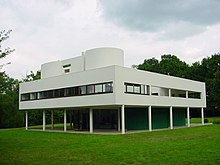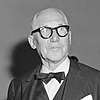
Charles-Édouard Jeanneret, known as Le Corbusier, was a Swiss-French architect, designer, painter, urban planner and writer, who was one of the pioneers of what is now regarded as modern architecture. He was born in Switzerland and acquired French nationality by naturalization on 19 September 1930. His career spanned five decades, in which he designed buildings in Europe, Japan, India, as well as North and South America. He considered that "the roots of modern architecture are to be found in Viollet-le-Duc".

Villa Savoye is a modernist villa and gatelodge in Poissy, on the outskirts of Paris, France. It was designed by the Swiss-French architect Le Corbusier and his cousin Pierre Jeanneret, and built between 1928 and 1931 using reinforced concrete.

Oscar Ribeiro de Almeida Niemeyer Soares Filho, known as Oscar Niemeyer, was a Brazilian architect considered to be one of the key figures in the development of modern architecture. Niemeyer was best known for his design of civic buildings for Brasília, a planned city that became Brazil's capital in 1960, as well as his collaboration with other architects on the headquarters of the United Nations in New York. His exploration of the aesthetic possibilities of reinforced concrete was highly influential in the late 20th and early 21st centuries.

Modern architecture, also called modernist architecture, was an architectural movement and style that was prominent in the 20th century, between the earlier Art Deco and later postmodern movements. Modern architecture was based upon new and innovative technologies of construction ; the principle functionalism ; an embrace of minimalism; and a rejection of ornament.
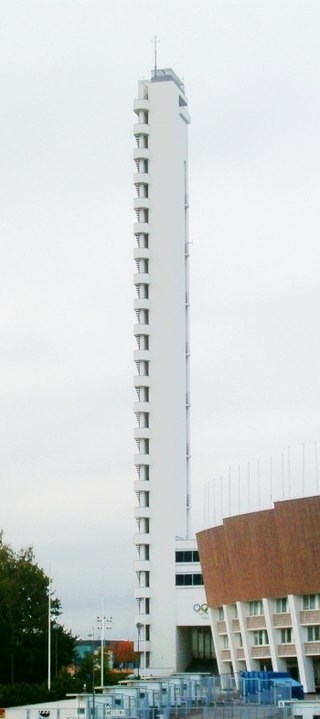
In architecture, functionalism is the principle that buildings should be designed based solely on their purpose and function. An international functionalist architecture movement emerged in the wake of World War I, as part of the wave of Modernism. Its ideas were largely inspired by a desire to build a new and better world for the people, as broadly and strongly expressed by the social and political movements of Europe after the extremely devastating world war. In this respect, functionalist architecture is often linked with the ideas of socialism and modern humanism.

Pilotis, or piers, are supports such as columns, pillars, or stilts that lift a building above ground or water. They are traditionally found in stilt and pole dwellings such as fishermen's huts in Asia and Scandinavia using wood, and in elevated houses such as Old Queenslanders in Australia's tropical Northern state, where they are called "stumps". Pilotis are a fixture of modern architecture, and were recommended by the modern architect Le Corbusier in his manifesto, the Five Points of Architecture.

Sainte Marie de La Tourette is a Dominican Order priory, located on a hillside near Lyon, France, designed by the architect Le Corbusier, the architect’s final building. The design of the building began in May 1953 and completed in 1961. The committee that decided the creation of the building considered that the primary duty of the monastery should be the spiritual awakening of the people and in particular the inhabitants of nearby areas. As a result, the monastery was constructed in Eveux-sur-Arbresle, which is just 25 km from Lyon and is accessible by train or car.

The Tsentrosoyuz Building or Centrosoyuz Building is a government structure in Moscow, Russia, constructed in 1933 by Le Corbusier and Nikolai Kolli. Centrosoyuz refers to a Soviet bureaucracy, the Central Union of Consumer Cooperatives. The building included office space for 3,500 personnel, as well as a restaurant, lecture halls, a theater, and other facilities. The address of the building is 39 Myasnitskaya Street, and the eastern side of the building faces Myasnitskaya Street. The western side, which was supposed to be the main entrance, faces Academician Sakharov Avenue. Currently it is the home of Rosstat, Russian Federal State Statistics Service and Federal Financial Monitoring Service.
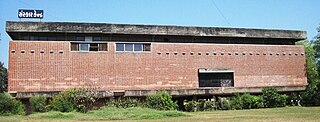
Sanskar Kendra is a museum at Ahmedabad, India, designed by the architect Le Corbusier. It is a city museum depicting history, art, culture and architecture of Ahmedabad. Another Patang Kite Museum is there which includes a collection of kites, photographs, and other artifacts. The campus is located at the west end of Sardar Bridge near Paldi.

Kunio Maekawa was a Japanese architect and a key figure in Japanese postwar modernism. After early stints in the studios of Le Corbusier and Antonin Raymond, Maekawa began to articulate his own architectural language after establishing his own firm in 1935, maintaining a continuous tension between Japanese traditional design and European modernism throughout his career. Firmly insistent that both civic and vernacular architecture should be rendered through a modernist lens appropriate to the contemporary lifestyle of the Japanese people, Maekawa's early work and competition entries consistently pushed back against the dominant Imperial Crown Style. His postwar prefab housing projects borrowed from manufacturing strategies in the automotive industry to create houses that privileged light, ventilation, and openness against the feudal hierarchical principles perpetuated by the interior divisions found in traditional Japanese homes.
In architecture, a free plan is an open plan with non-load-bearing walls dividing interior space. In this structural system, the building structure is separate of the interior partitions. This is made possible by replacing interior load-bearing walls with moving the structure of the building to the exterior, or by having columns that are free from space dividing partitions.

Junzo Sakakura was a Japanese architect and former president of the Architectural Association of Japan.

The Endo Pharmaceuticals Building, also known as "Endo Laboratories", is a pharmaceutical plant designed by architect Paul Rudolph in 1962 in Garden City, New York, in the receding farmlands of Long Island. The "castle-like structure" was built to house the Endo Pharmaceuticals research, manufacturing and administration facilities. It still stands today as an example of post World War II American architecture in the Brutalist style.
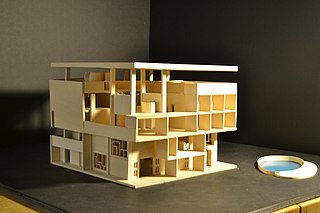
Villa Shodhan is a modernist villa located in Ahmedabad, India. Designed by the Swiss architect Le Corbusier, it was built between 1951 and 1956. Building on his previous projects whilst integrating the traditional features of Ahmedabad design, the villa symbolizes Le Corbusier's domestic architecture. The building is currently used as a private residence.
Villa Meyer (1925–1926) is an unbuilt project which was supposed to be built in Neuilly-sur-Seine, in downtown Paris. Four designs were created for this house by Swiss architect Le Corbusier, but it was never built. This is the first project into which Le Corbusier incorporated "free plan" and "free facade" into his design. These ideas later become two of Corbusier's famous Five Points of Architecture. Domino Frame is also an outcome of this experimental design, which became the dominant design concept of Corbusier's later works.
The Cité Frugès de Pessac(the Frugès Estate of Pessac), or Les Quartiers Modernes Frugès, is a housing development located in Pessac, a suburb of Bordeaux, France. It was commissioned by the industrialist Henri Frugès in 1924 as worker housing and designed by architects Le Corbusier and Pierre Jeanneret, who were responsible for the development's masterplan and individual buildings. It was intended as a testing ground for the ideas Le Corbusier had expressed in his 1922 manifesto Vers une Architecture and was his first attempt designing low-cost, mass-produced collective housing in his trademark aesthetic. Drawings of some of the buildings were subsequently included in the second edition of the text.
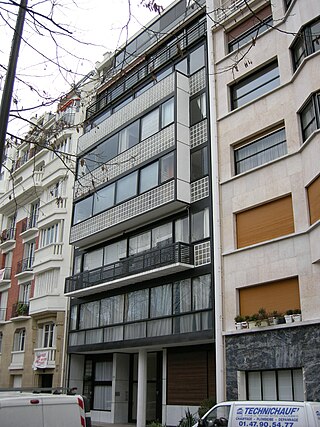
Immeuble Molitor is an apartment building designed by Le Corbusier and Pierre Jeanneret and built between 1931 and 1934. Located at the border between the city of Paris and the commune of Boulogne-Billancourt in France, it has been listed along with 16 other architectural works by Le Corbusier as a UNESCO World Heritage Site. Le Corbusier lived in the building from its completion until his death in 1965.
Promenade architecturale is a concept developed by Swiss-French architect Le Corbusier that refers to the implied "itinerary" of a built environment. Le Corbusier coined the term in reference to his houses: Villas La Roche and Savoye. In the study of architecture there is a longstanding tradition of walking to achieve spatial perception, of for example, a street, building or any spatial premises designed or otherwise. Throughout history the perception of spaces through movement, mainly by means of walking through or along them, has always been a recurring, yet often overlooked concept. Promenade architecturale refers literally to such a walk of perception, or in other words, an "Architectural walk".

The Villa Le Lac, also known as the Villa "Le Lac" Le Corbusier, is a residential building on Lake Geneva in Corseaux, Canton of Vaud, Switzerland, designed by Swiss architects and cousins Le Corbusier and Pierre Jeanneret between 1923 and 1924 for Le Corbusier's parents. It is an example of residential Modern architecture and showcases three of Le Corbusier's Five Points of Architecture. The building is a designated Swiss Cultural Property of National Significance and was added to the UNESCO World Heritage List in 2016.

The Hotel Rosita De Hornedo, located in the Puntilla area of Miramar, was one of the first major buildings to be built by a private developer in the 1950s in Havana.
